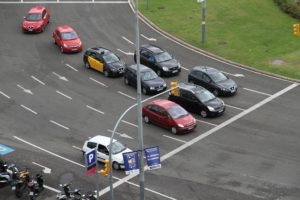
Some people don’t like driving abroad, but there is really no reason to avoid driving in Spain. As long as you know and follow the rules and regulations it is easy and convenient to drive in Spain. The roads are very good and in certain places you can choose to pay toll to save some time. But often, the free alternatives are just as good. Rush hour traffic and around and in big cities, the traffic can get congested but in general the traffic flows well.
The Spanish traffic isn’t particularly hectic either (it all depends on what you are used to of course, but Italian and French drivers seem to be more forceful than the Spanish, at least that is the opinion of the MiMove-blog. It you take your time and have the right gear in the car, then it is really an enjoyable experience.

Everyone in the car needs to wear seatbelts, even in the backseat. If you drive in Spain with animals in the car they are not to be loose. The law forbids loose animals in the car as they may disturb the driver. However, it is not regulated how the animal is the be secured, in a crate or a car harness. To use a seatbelt suitable for humans for your dog isn’t enough though, as it is neither safe for you nor for your dog.
Children shorter than 136 centimetres tall are not allowed to sit in the front of the car unless the child’s seat can’t be placed in the back. However, if the baby is under 3 years of age, it always has to travel in the back. Children shorter than 150 centimetres must sit on a booster seat or in a child’s seat.
Generally speaking, the speed limits are: 120 km/h on dual carriageways and motorways (autopista), 100 km/h on conventional roads (autoviva), 90 km/h on all other roads in built up areas, and 50 km per hour within city limits. In certain places there might be local regulations overriding the general. For example, the speed limit is lower in tunnels and on exits and on highway access.
Regardless of the number on the signs, the driver always has to adjust the speed to the situation; ques, weather, road works etc.

When driving on the highway you should position your car in the right-hand lane in accordance with your speed. Should there be a gap in the traffic to the right you should fall in there and overtake the car in front on the left-hand side when you reach it. The lanes to the left is for overtaking only. This is followed very well by locals and the traffic often flows well. As the left lane is often empty it is easy to overtake and keep your own rhythm.
There is not a manadatory requirement to have your headlighs on during the day but it does increase the visability to other drivers. In tunnels and in poor daylight (and of course in darkness) you need to use the headlights.
For right-hand drive cars (from Britain or Ireland), you will need a headlamp converter for night driving.
Fuel prices are decided centrally so there is no point in shopping around.
Most service stations sell 95-octane unleaded petrol (gasolina), 98-octane unleaded petrol (gasolina sin plomo), Diesel A and Biodiesel. Diesel is called gasóleo or gasoil.

Often the access road is quite short, and it is the driver’s responsibility to ensure safe entrance to the motorway. Sometimes, the traffic is just too heavy, and you won’t see a gap big enough to enter safely, then you need to simply reduce your speed or stop the car and wait for a better moment.
In other countries that is not the case but in Spain you will frequently see cars coming to a stand-still while they are waiting for an opportunity to enter the motorway. Most drivers are helpful and try to stay clear of the right-hand lane. It is good to remember that some cars entering the motorway drive at a much slower pace than the cars already on the road. Sometimes, the short access roads can cause stress to foreign drivers but just take your time and stop the car if you need to. There will be an opportunity for you to enter the motorway if you just give it a little time.
If you speed of violate some other traffic regulation and your are fined, there are several ways to pay your fine. You may use the phone number 060 (from Spain) and use your credit card, however the service is only in Spanish. It is also possible to pay online using your credit card or go to the bank (Caixa bank) or postal office where you can use either credit card or cash. You can also go to a local traffic office in the province.
The fines in Spain can be perceived as excessively high, sometimes as high as what a regular Spaniard makes in a month or higher (depending on the violation of course) and it is sound to follow the rules and regulation. If you pay within 20 days, you will get a discount of 50 percent. If you are fined by local police in a city, it is recommended to go to the traffic office in that town. And if you pay cash directly to the police that stopped you, remember to ask for a receipt.

When driving in Spain, you find certain driving extra stressful – like roundabouts. But there is really no need. The general rule of priority to the right is replaced in favour of those who are already driving inside a roundabout.
You should always give way to those already driving inside it and choosing the most convenient lane according to the exit you want to take. Once inside the roundabout, the car already driving on the lane always has the right of way.  Cars in the outer lane always have priority. You have the right to enter it and stay in the outer lane for the duration of your time in the roundabout. Should it not be possible for you to move to the outer lane, you will have to drive around the roundabout again and take the proper lane safely in advance.
Please remember that circulation in a roundabout is always anti-clockwise.
Sometimes, a roundabout can have 5 or 6 lanes and poor markings on the road. It may then feel stressful to try and find your way. But take your time and drive an extra lap should you need it. As long as you drive slowly and indicate which way you would like to take. The larger roundabouts may also have traffic lights and special markings on the road, those have priority to the general rules.
You need to carry reflective vests for all in the car. Should you need to vacate the car on the road, or on the hard shoulder, you need to wear the vest.
You must have a warning triangle in the car. The legal requirement is to carry one, but it may be advisable to carry two, sometimes it is needed.
If you under normal circumstances wear glasses while driving, you need a spare pair in the car while driving in Spain. And of course, you also need an extra tyre and tools to change the tyre if you need to.
You need to be over 18 years of age and carry an international or EU driver’s license. Don’t forget the cars’ insurance papers.

Spain allow 0.5 milligrams of alcohol per millilitre of blood – stricter than some countries more relaxed than others. New drivers, with less than two years since they got their license are allowed less than 0.3 milligrams of alcohol per millilitre of blood.
In case of an accident you have to call the police if there are injuries. If there are only material damage you are free to handle it yourself. However, if you call for the police you will get proper documentation.
Mobile talk
You are only allowed to talk on the phone while driving in Spain if you use hands free. Not even headphones are acceptable. During refuelling, you have to turn your mobile off as well as the radio.
Studded tyres are not allowed while driving in Spain. You may use snow chains when necessary. Sometimes, you even have to fit snow chains to be allowed up the mountain in, for example Sierra Nevada.
